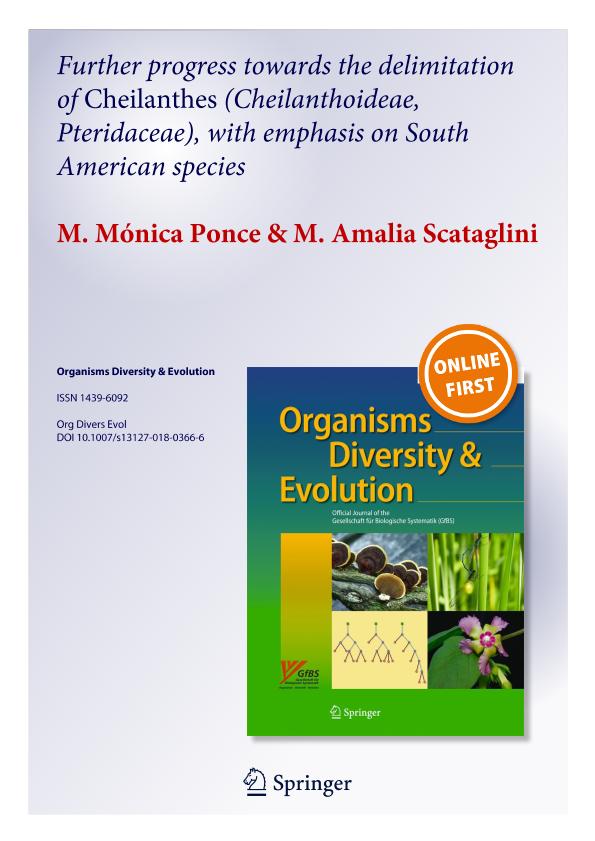Mostrar el registro sencillo del ítem
dc.contributor.author
Ponce, Marta Monica

dc.contributor.author
Scataglini, María Amalia

dc.date.available
2020-01-31T14:15:03Z
dc.date.issued
2018-06
dc.identifier.citation
Ponce, Marta Monica; Scataglini, María Amalia; Further progress towards the delimitation of Cheilanthes (Cheilanthoideae, Pteridaceae), with emphasis on South American species; Springer Heidelberg; Organisms Diversity & Evolution; 18; 2; 6-2018; 175-186
dc.identifier.issn
1439-6092
dc.identifier.uri
http://hdl.handle.net/11336/96357
dc.description.abstract
Cheilanthoid ferns (Cheilanthoideae sensu PPG 1 2016) constitute an important group within the Pteridaceae and are cosmopolitan in distribution. In South America, there are 155 species distributed in 13 genera, among which the largest are Adiantopsis (35), Cheilanthes (27), and Doryopteris (22). Most of the cheilanthoid species are morphologically adapted to grow in arid to semi-arid conditions and show convergent evolution, which has implied difficulties in defining the genera throughout their taxonomic history (Copeland 1947, Tryon & Tryon 1973, Gastony & Rollo 1995, 1998, Kirkpatrick Systematic Botany, 32: 504–518, 2007, Rothfels et al. Taxon, 57: 712–724, 2008). Here, we sequenced two plastid markers (rbcL + trnL-F) of 33 South American cheilanthoid species, most of which have not been included in phylogenetic analyses previously. The South American species were analyzed together with South African and Australasian Cheilanthes and representatives of related cheilanthoid genera. The phylogenetic analysis showed that most Cheilanthes species are related to the genus Hemionitis, constituting different groups according to their distribution; moreover, three species—C. hassleri, C. pantanalensis, and C. obducta—appear as the sister clade of Hemionitis. Cheilanthes micropteris, the type species, is strongly supported in a clade with Australasian Cheilanthes plus five South American Cheilanthes species, all of which show a reduction in the number of spores per sporangium; this feature would be a synapomorphy for core Cheilanthes s.s. We found no support uniting other South American Cheilanthes to either the group of South African Cheilanthes or to core Cheilanthes s.s. On the other hand, C. geraniifolia, C. goyazensis, and C. bradei formed a clade related to Doryopteris that, with further study, could be considered as a new genus. The phylogenetic hypotheses presented here contribute substantially to the delimitation of Cheilanthes s.s. and related groups and provide the basis for re-examining the generic taxonomy.
dc.format
application/pdf
dc.language.iso
eng
dc.publisher
Springer Heidelberg

dc.rights
info:eu-repo/semantics/openAccess
dc.rights.uri
https://creativecommons.org/licenses/by-nc-sa/2.5/ar/
dc.subject
CHEILANTHES
dc.subject
HEMIONITIS
dc.subject
PHYLOGENY
dc.subject
RBCL
dc.subject
SOUTH AMERICA
dc.subject
TRNL-TRNF
dc.subject.classification
Ciencias de las Plantas, Botánica

dc.subject.classification
Ciencias Biológicas

dc.subject.classification
CIENCIAS NATURALES Y EXACTAS

dc.title
Further progress towards the delimitation of Cheilanthes (Cheilanthoideae, Pteridaceae), with emphasis on South American species
dc.type
info:eu-repo/semantics/article
dc.type
info:ar-repo/semantics/artículo
dc.type
info:eu-repo/semantics/publishedVersion
dc.date.updated
2019-10-18T17:59:55Z
dc.journal.volume
18
dc.journal.number
2
dc.journal.pagination
175-186
dc.journal.pais
Alemania

dc.journal.ciudad
Heidelberg
dc.description.fil
Fil: Ponce, Marta Monica. Consejo Nacional de Investigaciones Científicas y Técnicas. Instituto de Botánica Darwinion. Academia Nacional de Ciencias Exactas, Físicas y Naturales. Instituto de Botánica Darwinion; Argentina
dc.description.fil
Fil: Scataglini, María Amalia. Consejo Nacional de Investigaciones Científicas y Técnicas. Instituto de Botánica Darwinion. Academia Nacional de Ciencias Exactas, Físicas y Naturales. Instituto de Botánica Darwinion; Argentina
dc.journal.title
Organisms Diversity & Evolution

dc.relation.alternativeid
info:eu-repo/semantics/altIdentifier/url/https://link.springer.com/article/10.1007/s13127-018-0366-6
dc.relation.alternativeid
info:eu-repo/semantics/altIdentifier/doi/http://dx.doi.org/10.1007/s13127-018-0366-6
Archivos asociados
